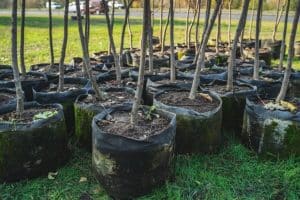Proper tree pruning is essential for maintaining the health, structure, and aesthetics of trees in any region, and Florida’s subtropical climate presents unique considerations.
By understanding the optimal times for pruning and following expert techniques, homeowners and professionals can ensure thriving, well-maintained trees throughout the year.
Importance of Proper Tree Pruning
Tree pruning is more than just snipping away at branches; it’s a science aimed at promoting tree health, safety, and aesthetics.
In Florida, where the climate poses specific challenges and opportunities, the importance of proper pruning cannot be overstated.
Unique Climate Considerations in Florida
Scorching Summers
Florida is renowned for its hot and humid summers, characterized by soaring temperatures and intense sunlight.
These conditions can place stress on trees, leading to issues such as dehydration and sunburn.
Additionally, the high temperatures can accelerate water loss through transpiration, making it essential for trees to have access to an adequate water supply.
Mild Winters
Unlike many other parts of the country, Florida experiences relatively mild winters with temperatures rarely dipping below freezing, especially in the southern regions.
While this may seem advantageous for tree growth, it also means that certain tree species accustomed to colder climates may struggle to enter dormancy properly.
This can affect their pruning requirements and overall health.
Frequent Rainfall
Florida is known for its abundant rainfall, especially during the summer months due to the state’s proximity to the Atlantic Ocean and the Gulf of Mexico.
While this rainfall is vital for sustaining tree health, excessive moisture can also create favorable conditions for fungal diseases and root rot.
Proper pruning techniques can help mitigate these risks by improving airflow and reducing moisture buildup within the canopy.
Hurricanes and Tropical Storms
Florida is no stranger to hurricanes and tropical storms, which can wreak havoc on trees and landscapes.
High winds, heavy rainfall, and flying debris during these extreme weather events can cause significant damage to trees, leading to broken branches, uprooting, and structural instability.
Pruning trees to remove dead or weak branches can reduce the risk of storm damage and enhance overall resilience.
Factors to Consider for Optimal Tree Pruning Time in Florida
Tree Species
Different tree species have varying growth habits and responses to pruning.
In Florida, understanding the distinction between deciduous and evergreen trees is crucial for determining the best pruning practices.
Deciduous trees, such as oak and maple, undergo a period of dormancy in the winter when they shed their leaves.
This dormant phase is an ideal time for pruning as it minimizes stress on the tree and allows for more precise shaping and corrective cuts.
Evergreen trees, like pine and magnolia, retain their foliage year-round, making their pruning needs slightly different.
Tree Growth Cycles and Dormancy Periods
Timing pruning activities to coincide with tree dormancy periods is essential for promoting healthy growth and minimizing stress.
During dormancy, trees allocate resources towards root development and preparation for the upcoming growing season.
In Florida, where winters are relatively mild, deciduous trees may have shorter dormancy periods or enter dormancy later in the season.
Arborists and landscapers must closely monitor local weather patterns and tree behavior to identify optimal pruning windows.
Climate Conditions
Florida’s climate is characterized by high temperatures, humidity, and frequent rainfall, which can influence tree growth and response to pruning.
Extreme heat and humidity during the summer months may increase the risk of stress-related injuries if trees are pruned during this time.
Additionally, heavy rainfall can saturate the soil, making it challenging to access trees for pruning activities.
Monitoring weather forecasts and scheduling pruning tasks during periods of milder temperatures and lower humidity can help minimize stress on trees and ensure optimal results.
Potential for Storm Damage or Disease
Pruning strategically can help mitigate the risk of storm damage and reduce the spread of diseases in Florida’s trees.
Removing dead, diseased, or weak branches can improve the structural integrity of trees, making them more resilient to wind and rain during hurricanes and tropical storms.
Additionally, proper pruning techniques, such as making clean cuts and sanitizing tools, can prevent the transmission of pathogens between trees.
Best Time for Pruning Deciduous Trees in Florida
Late Winter or Early Spring Timing: Late winter or early spring, typically from late February to early April in Florida, marks a crucial window for pruning deciduous trees.
This timeframe aligns with the end of winter dormancy and precedes the onset of new growth in the spring. Pruning during this period offers several key advantages:
Dormancy Transition
Deciduous trees enter a state of dormancy during the winter months, conserving energy and slowing growth.
Pruning during late winter or early spring allows for a smooth transition out of dormancy as temperatures begin to rise.
This timing ensures that trees are actively preparing for the upcoming growing season, making them more responsive to pruning stimuli.
Promotes Healthy Growth
By pruning before the onset of new growth, typically signaled by bud break, trees can allocate resources more efficiently.
Removing dead, damaged, or overcrowded branches during this period stimulates new growth and encourages the development of a strong, well-balanced canopy.
This promotes overall tree health and vigor, setting the stage for robust growth throughout the growing season.
Corrects Structural Issues
Late winter or early spring pruning provides an opportunity to address structural issues and shape the tree’s form.
This includes removing crossing or rubbing branches, correcting branch angles, and reducing canopy density to improve airflow and light penetration.
Corrective pruning during this period helps establish a strong framework for the tree, enhancing its stability and longevity.
Minimizes Stress
Pruning during late winter or early spring minimizes stress on the tree by avoiding periods of active growth or extreme weather conditions.
Trees are better able to recover from pruning cuts during this time, with reduced risk of sap loss, disease entry, or negative physiological responses.
This results in faster healing and minimal impact on tree vitality.
Best Time for Pruning Evergreen Trees in Florida
Late Spring or Early Summer Timing: Late spring, typically from late May to early June, or early summer, from June to July, is considered the ideal window for pruning evergreen trees in Florida.
This timeframe offers several advantages for the health and well-being of the trees:
Avoids Extreme Heat
Pruning during late spring or early summer allows trees to avoid the intense heat and humidity of the peak summer months in Florida.
High temperatures can stress trees and exacerbate the effects of pruning, leading to increased water loss, sunburn, and dehydration.
By waiting until late spring or early summer, when temperatures are generally milder, trees can recover more effectively from pruning cuts without undue stress.
Minimizes Sunburn
Evergreen trees, with their year-round foliage, are more susceptible to sunburn, especially when pruned during hot, sunny weather.
Pruning during late spring or early summer reduces the risk of sunburn damage to newly exposed branches and foliage.
The cooler temperatures and lower intensity of sunlight during this period help mitigate the risk of sunscald and leaf scorch, preserving the health and appearance of the trees.
Facilitates Healing
Pruning wounds heal more quickly and effectively when trees are actively growing and transpiring.
Late spring and early summer coincide with the peak growing season for most evergreen trees in Florida, providing optimal conditions for wound closure and regeneration.
Trees can allocate resources towards healing pruning cuts and producing new growth, enhancing their resilience and vitality.
Reduces Risk of Dehydration
Pruning during late spring or early summer helps minimize the risk of dehydration, particularly for newly exposed branches and foliage.
Evergreen trees transpire water continuously through their leaves, and pruning can temporarily disrupt this process.
By pruning when temperatures are moderate and soil moisture levels are typically higher, trees can maintain adequate hydration levels and reduce the stress associated with pruning.
Benefits of Proper Pruning
- Improved Tree Health and Structure: Pruning removes dead or diseased branches, allowing trees to allocate resources more efficiently.
- Increased Air Circulation and Sunlight Penetration: Proper pruning enhances airflow and sunlight exposure, promoting photosynthesis and overall tree vigor.
- Enhanced Aesthetics and Curb Appeal: Well-pruned trees contribute to a visually appealing landscape and add value to properties.
- Prevention of Storm Damage and Disease: Strategic pruning reduces the risk of limb breakage during storms and helps prevent the spread of pathogens.
Our team provides expert tree pruning in Tampa to enhance structural integrity, promote healthy regrowth, and boost the visual appeal of every landscape.
Expert Tips for Successful Tree Pruning
- Hiring a Tree Service Professional: Professional expertise ensures proper assessment and execution of pruning practices.
- Proper Pruning Techniques: Thinning, heading, and shaping cuts should be performed according to industry best practices to avoid damage and promote healthy regrowth.
- Sanitizing Tools: Disinfecting pruning tools between cuts and trees prevents the transmission of diseases.
- Addressing Potential Safety Concerns: Identifying and mitigating safety hazards, such as unstable branches or power lines, is essential for a safe pruning process.
Homeowners who want it done right the first time often turn to Tampa seasonal pruning specialists like Panorama Tree Care, who understand both tree biology and Florida’s seasonal rhythms.
Common Mistakes to Avoid during Tree Pruning
- Over-Pruning: Removing too many branches can stress trees and compromise their structural integrity.
- Pruning at the Wrong Time of Year: Timing is crucial; pruning outside of dormancy periods can harm trees and inhibit growth.
- Improper Pruning Techniques: Topping or making stub cuts can lead to decay and weaken trees over time.
- Neglecting Tool Maintenance: Dirty or dull tools can cause injuries to both trees and pruners and increase the risk of disease transmission.
Conclusion
Understanding the best time for tree pruning is essential for maintaining healthy, thriving trees in the state’s unique subtropical climate.
By considering factors like tree species, growth cycles, and climate conditions, homeowners and professionals can determine the optimal pruning periods for deciduous and evergreen trees.
Remember, proper pruning techniques, expert guidance, and regular maintenance are crucial for promoting tree health, longevity, and aesthetic appeal.
Give your trees the seasonal care they deserve. Contact Panorama Tree Care today to schedule your professional pruning service and ensure your Florida trees stay healthy, resilient, and beautiful all year long.







